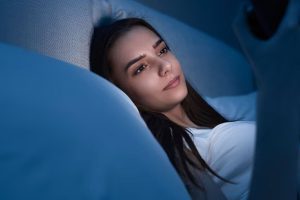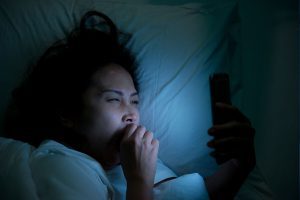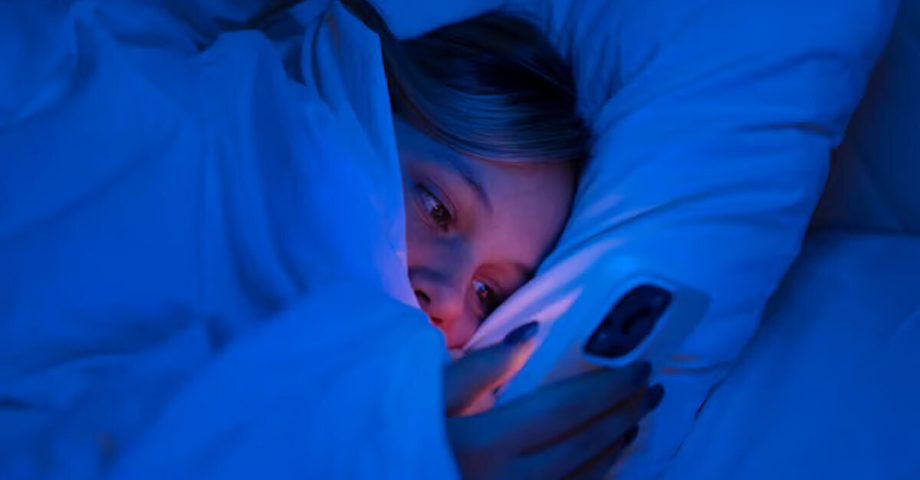Did you know your digital devices emit blue light? It is generally not a threat during the daytime, but it can interfere with your sleep at night. The blue light tricks your brain into thinking it is daytime, so you have a hard time falling asleep.
Here’s a full blow-by-blow of how blue light is dangerous and things you can do to stop it from disrupting your sleep.
What is the Meaning of Blue light?
High-energy visible light or blue light is a colour in the visible light spectrum that humans can see. Due to its short wavelength, it produces higher amounts of energy.
Human eyes cannot filter blue light effectively, and that’s why more passes through the eye to the retina.
Everyone is constantly exposed to blue light, which is the largest source of sunlight. Blue light is also emitted by computer monitors and laptops, tablets, smartphones, etc. Although moderate amounts of blue light are considered beneficial, today’s concern is due to people’s growing dependency on digital devices.

Risks of Blue Light Exposure
Excessive blue light exposure results in sleep disruption, headaches, dry eyes, reduced concentration, and more. Therefore, if you follow the tips & tricks to reduce or stop blue light exposure from interfering with your sleep, it will also enhance your overall well-being.
Steps to Stop Blue Light From Disrupting Sleep
1. Turn on ‘Night Shift’
Understanding the concerns of blue light, most digital devices come with in-built features to reduce blue light exposure.
For example, iPhones, iPads, and Macs come with a feature called ‘Night Shift’. This feature differs from dark mode as it adjusts the levels of blues emanating from the device when it detects a darker environment. Dark mode, on the other hand, turns the interface for many native apps and the background to a darker colour scheme.
You can turn on Night Shift on your iPhone/iPad by going to Settings > Display & Brightness >tap the Night Shift setting. This will filter out blue light and alter the screen to display colours of a warmer colour temperature.
On your Mac, you can turn on this setting by going to System Preferences > Displays > Night Shift.
If you wish to get more control over Night Shift, you can play around with the settings while in the Night Shift panel on any of your Apple devices. For example, you can create a custom schedule or set it to turn on and off based on the time of day. You can even adjust the colour temperature.
Other smartphones and computers also have technology designed in the hardware to reduce blue light exposure. Play around with the settings or call customer support to find out all the available features.
2. Reduce screen time
One of the best ways to stop blue light from disrupting your sleep is by cutting down on screen time. Remember to take regular breaks from TV or computer screens, smartphones, or tablets. This gives your eyes much-needed rest and limits blue light exposure.
You can follow the 20-20 rule. For every 20 minutes of using your digital devices, you must look elsewhere for at least 20 seconds.
3. Limit night-time browsing
It is essential to take breaks from using your digital devices in the evening. It is best to power down your smartphones or computers at least three hours before bed. This will help you to stop the blue light from impacting your body’s release of the sleep hormone melatonin. As a rule of thumb, more melatonin means better sleep.
Therefore, you must reduce browsing or playing games in the evening. Also, you must keep your phone away when in bed, or your mind will be conditioned to think it is not time to sleep.
4. Wear blue light glasses
Consult your doctor and get blue light glasses to safeguard your eyes from sunlight and other artificial sources of blue light.
You can wear zero power lenses with a blue block feature if you are prescribed with high powers, you can opt for blue-ray protection coating with your power lenses.

5. Regular eye exams
If you are always on your phone or computer, you must regularly consult your doctor and get your eyes examined. Professionals can help you come up with ways and solutions to protect yourself and your loved ones from the risks of blue light exposure.
Final thoughts
Blue light is not going anywhere, and the use of digital devices will only increase with time. As the world gets more obsessed with doing everything online, blue light exposure shows an upward trajectory. Therefore, if you are unable to sleep at night and you’ve tried everything possible, the culprit might be your digital devices. Follow the tips and tricks mentioned above to reduce blue light exposure, and you should be able to get a good night’s sleep.









